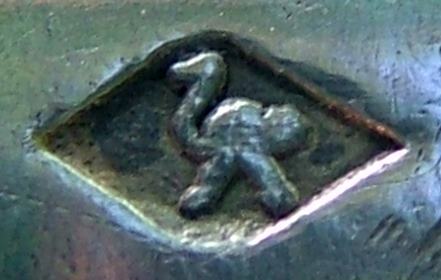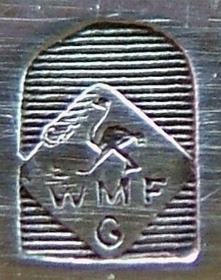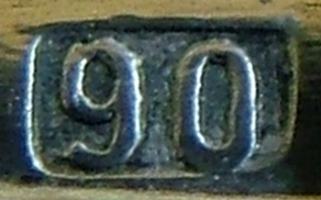(click on photos to enlarge image)
MARKS OF EUROPEAN SILVER PLATE : XV.
WÜRTTEMBERGISCHE METALLWARENFABRIK (WMF)
Marks of Cutlery & Napkin Rings.
Thousands of people enjoy collecting German silver and silver-plated
cutlery. Many German cutlery manufacturers reached the peak of their
production just before the World War I. For example, the famous factory
August Wellner Söhne in Aue, Saxony, had fabricated 3 million dozen of
cutlery pieces (spoons, forks and knifes) in 1911 [1]. Simultaneously, this
pre-war period (c.1890 - 1914) coincided well with the appearance and
development of a new art style in Germany - "Jugendstil" (Art Nouveau in
France, Secession in Austria-Hungary, Art and Crafts in Great Britain), see
recent monograph of Barbara Grotkamp-Schepers and Reinhard W. Sänger
[2]. It should be emphasized that the highest profit silver factories always
received was not from the sterling-silver products but from the manufacture
of silver-plated ones, which were by the order of magnitude cheaper and
therefore had a much larger market. Hence the silver-plated cutlery was fabricated in great numbers
and it was mostly subject to the design/fashion of the day. That, at the end of XIXth -
beginning of XXth century, meant Jugendstil (Art Nouveau). Concluding, the
German silver-plated cutlery was a mass-fabricated and at the same time a
very diversified product.
Early silver-plated WMF cake server with a butterfly motif made before 1887.
|
The above explains why now, more than one hundred years later, such a
hobby attracts numerous people: the silver-plated cutlery is wide-spread
and due to the huge amount of produced pieces it is easy accessible to any
collector, even to those with limited funds. In addition, it brings into
today's reality the essence of the Art Nouveau epoch, making the collector's
life far from being boring.
As a disadvantage of such a hobby, a lack of information on German
silver factories and their production models (Muster in German) should be
mentioned. The information on WMF cutlery marks is especially poor. In the
monograph [2], only two WMF cutlery marks are mentioned. In the
monograph [3], named "Das deutsche silber-Besteck", only one WMF mark is
cited, which was developed for hollow ware pieces.
At the same time the number of WMF cutlery marks is well above 50. My
collection of WMF cutlery is rather young and counts only about 200 pieces.
However, it is a special collection, as my target was not to collect all size
cutlery and different models, but to find all possible mark varieties. The
dating of the WMF cutlery marks used before 1930 is rather easy as they
obey the same rules as WMF hollow ware marks, discussed by me earlier [4].
I was lucky to find eight cutlery pieces (including napkin rings) which have
been dated between 1886 and 1924. This allowed me to date some cutlery pieces and check/confirm the correlation between the WMF cutlery marks and those of hollow ware.
Silver-plated Art Nouveau WMF fish-set made in 1886-1903.
|
As WMF hollow ware marks with WMF letterings, the cutlery ones used in 1880-1903 also could be divided in four groups. The marks from the first group, used in 1880-c.1886, contain the word "WMF" formed of three letters, "W", "M", and "F", with dots in between or without. All the inscriptions amongst WMF cutlery marks from the first group were made with a "sans serif" font. Sometimes, the letters "M" and "F" are joined (connected together). Known marks are given below in the "List of WMF Cutlery marks".
The second group (1886-1903) contains numerous marks with four-letter inscriptions, with dots or without, made with both "serif" and "sans serif" fonts and sometimes put in a cartouche. The word "WMF" was combined with the following letters: "M" or "N", notating in such a way the base metal used for silvering, that means brass ("M" refers to "Messing", German term for brass) or nickel silver ("N", refers to "Neusilber" or "Alpacca" ), respectively. Rarely, mainly for markings on napkin rings, the letter "B" (Britannia metal) was also used for marking.
Typical cutlery marks from the second group (1886-1903)
|
Some WMF cutlery marks from the second group are presented above. More older marks are made with a "serif" font and put in a cartouche. The most abundant are different varieties of WMFN mark. It is clear that with the passage of time the smaller fonts and/or italics were used. Interestingly, some WMFN marks are dot-less, while others include one, two, three or even four dots. The reason for that peculiarity is still unknown.
The third group of WMF cutlery marks (1898-1903) doesn't contain any three- or four-letter WMF inscriptions. Instead, it consists of a one-word inscription "GEISLINGEN", made by a "sans serif" " font and put in a rectangular frame. As corresponding hollow ware mark of the same period, the cutlery mark was issued in order to designate the use of Argentan alloy as a base metal for silver-plating. Below I am presenting two ancient WMF advertisements of "Geislinger Argentan Bestecke" (Geislingen Argentan Cutlery), which tell us that such cutlery was made from silver-plated Argentan (other names Alfenide, Alpacca, Neusilber). The lower ad also informs that the delivery of such cutlery could not be effected to a private address but only to the jewellery shops or WMF branch offices.
Ancient WMF advertisements issued in 1898 (above) and 1903 (below). Property of David N. Nikogosyan.
|
It should be noted that according to the items in my collection, a small
part of WMF cutlery, marked by WMFN with "N" letter referring to Neusilber
(in English "nickel silver") metal base, in reality does not contain this alloy,
but uses instead ordinary brass (in German "Messing"). I think that from the
beginning this was a kind of gimmick: in order to attract more buyers, the
factory announced a long-lasting silver-plated cutlery. Indeed, the use of Neusilber as a base metal for silvering has a great advantage, after the thin silver layer has been rubbed out, the general outlook doesn't change much, as Neusilber metal looks very similar to silver.
However, decorative WMF cutlery pieces,
especially, cake servers (in German "Tortenhebers"), were very popular and
people bought them not because of their long-lasting quality, but for their
unbeatable charm and beauty. In the period between c.1890 and c.1903 this
circumstance brought the WMF cutlery production to huge unprecedented
growth. It should be emphasized that many famous Jugendstil cutlery
models (in German "Muster") were created exactly in this period, under the
WMFN mark (see below).
Detail of cake server issued between 1886 and 1903.
|
The fourth group of WMF cutlery marks (c.1886-c.1903) represents so-called export marks (see accompanied paper on WMF hollow ware marks), which use the three-letter WMF inscriptions without joined letters, with or without dots and made with "sans serif" (old "fancy" mark) or "serif" fonts.
Typical WMF export cutlery marks used between 1886 and 1903.
|
In 1903 all WMF cutlery marks were replaced by so-called WMF "ostrich cutlery mark", see accompanied paper on WMF hollow ware marks. It is widely accepted, that the use of the ostrich image for WMF mark could be explained by the consonance between the family name of one of WMF founders (Straub) and the German name of the ostrich (Strauss), see my accompanying paper on marks of WMF hollow ware. I found that four Art Nouveau (Jugendstil) different ostrich cutlery marks existed: two marks could be called "ostrich in rhombus", they are distinguished by the rhombus form and its position. The mark "ostrich in vertical rhombus" is, in my opinion, the most beautiful one, but it is extremely rare. According to my latest findings, this mark was used as an export mark for cutlery in the period 1903-1910. Contrary to that, the second mark "ostrich in horizontal rhombus", is common and was widely used throughout 1903-1910. The last two marks could be named as "ostrich in rhombus in arch". They contained the image of ostrich put in rhombus, which is further placed inside a fully- or partly-dashed arch, respectively. These last two marks are identical to corresponding WMF hollow ware marks, which existed in same time (1909-1930 and 1910 - 1925), but of course they are of smaller size. An exception is the ostrich mark, put on the items made solely of non-ferrous metals (ladles). Due to technical reasons this mark is of a rather large size, see the list of WMF cutlery marks below.
Four Art Nouveau WMF ostrich cutlery marks, used between 1903 and 1930.
|
In 1920, WMF introduced two new cutlery marks. One was used for standard silver-plated cutlery items like table cutlery, including knives. It contained a special 2D combination of three letters, "W", "M", and "F", placed in a rectangle [5]. This cutlery mark fully corresponds to the WMF hollow ware mark used in the same period.
WMF 2D cutlery mark, used in 1920-1930.
|
Another cutlery mark, used simultaneously in the same period (1920-1930), was applied on large silver-plated cutlery items like ladles, cake servers spoons for ragout, serving forks (in German Vorlegegabel), etc. This mark was very simple, the three-letter inscription "WMF". Below some varieties of this mark are presented. The peculiarity of this cutlery mark is the extremely uniform thickness of the line used in the inscription, which could be easily viewed while looking at the blow-up photos of the mark or using a microscope. Such an oddity doesn't occur in the next main WMF cutlery marks used after 1930 (I don't touch this subject in the current paper).
Second cutlery mark, used in the period 1920-1930.
|
Recently, I have found the Art Deco WMF cutlery mark (1925-1930), which is the same as the corresponding Art Deco mark for WMF hollow ware, see my accompanying paper. It contains again the image of ostrich in the horizontal rhombus without any attendant inscriptions. I suppose that this mark was used for marking the WMF products, made from non-ferrous metals without any silvering, but of "higher artistic quality" (see photos below)
Art Deco WMF cutlery mark, used in 1925-1930.
|
Two similar WMF ladles made of non-ferrous metals without any silvering. The upper ladle of higher artistic quality is marked by ostrich Art Deco mark (1925-1930), while the lower one is stamped by an ostrich in rhombus inside a fully-dashed arch (1909-1930).
|
My mark investigation brought interesting results. Having cutlery pieces of defined model and with defined mark of issue, it became possible to identify the period of time when this cutlery model was used for the first time. For example, I found that according to the pieces from my collection the famous WMF models No.23 (ivy, in German Efeu), No.34 (cube, in German Würfel), No. 37 (wave bands, in German Bänder), No.42 (ear, in German Ähren) and No.44 (name unknown) were already in use before 1903. This finding contradicts the information given in [2], where it is stated that these models were in use since 1903, 1907, 1904, 1914 and 1905, respectively.
Cake server issued between 1887 and 1903.
|
Ending this introductory text, I wish to mention the so-called "shortened marks" (in German "die kurze Punzen"), used by WMF to mark some pieces of cutlery. Indeed, they represent only the designation of the silvering degree, e.g. "I/O", "O", 90, 60, 18, 12, 8, etc., see the examples below. After hard and prolonged thinking, I realised that these marks refer to so-called "replacement pieces". Imagine, some family, restaurant, or hotel possesses a set of the cutlery. Occasionally, one or a few pieces from this set could be broken, lost or stolen. They (family, restaurant or hotel) will order such new pieces, but as time passed it is probable that the original mark is not valid anymore, or this model is out of fashion and so on. What will the silver factory will do? It will make the new substitution items, but mark them differently to distinguish them from the genuine ones. Therefore, they will mention only the silvering information. By the way, such firms are still active in USA or UK [6].
So-called WMF "shortened marks".
|
LITERATURE
[1] Sächsische Metallwarenfabrik August Wellner Söhne, Aue in Sachsen:
Alpacca, Versilberte und Unversilberte Bestecke, Hotel- und Tafelgeräte
(Aue, 1915), pp.1-274.
[2] Barbara Grotkamp-Schepers and Reinhard W. Sänger. Bestecke des
Jugendstils. Bestandskatalog des Deutschen Klingenmuseums Solingen.
(Stuttgart: Arnoldsche Art Publishers, 2000), pp.1-216.
[3] Reinhard W. Sänger. Das deutsche Silber-Besteck 1805-1918:
Biedermeier Period, Historicism and Art Nouveau. (Stuttgart: Arnoldsche
Art Publishers, 1991), pp.1-286.
[4] David N. Nikogosyan. Marks of European Silver Plate: XIV.
Württembergische Metallwarenfabrik (WMF) - Marks of Hollow Ware and Trays http://www.ascasonline.org/windowFEBBRA105.html
[5] Katalog der Württembergische Metallwarenfabrik. Geislingen-Steige, Niederlage Dresden. English translation of the title: Catalogue of the products issued by Wurtemberg Metallware company in Geislingen-Steige,
Dresden branch, c.1925-1930, pp.1-64.
[6] See, for example, www.replacements.com
List of WMF Cutlery & Napkin Rings Marks
For each mark, first the main inscription/image is given, then the full
images together with the secondary markings are presented, after that each
secondary marking is illustrated and explained.
|
N°
|
PERIOD & MARK
|
COMMENT
|
|
1
|
1880 - c.1886





|
The first group of WMF cutlery marks contains the inscription composed of three letters, "W",
"M", and "F", sometimes the letters "M" and "F" are joined together. All inscriptions are
made with a "sans serif" font. In some cases, the dots inside the inscription and after it are also present. The length of
"WMF" inscriptions (if no dots inside) is 2.9 mm. I suppose that some marks from this group are yet unknown. In some cases, the dots are inside the inscription and after it. The length of the "WMF" inscription (without the last dot, if any) varies in the range 2.9-3.9 mm. I suppose that some marks from this group are yet to be found.
|
|
|


|
A full WMF mark image for the first group contains also some secondary markings. So far only
the silver content designation marks (in grams of silver used for silvering of two dozen standard cutlery pieces) are known.
|
|
2
|
c.1886 - c.1903













|
The second group of WMF cutlery marks contains the marks with four-letter letterings, with dots or without, which are the combinations of the word "WMF" with the letters " M" (rarely) or "N". In rare cases (napkin rings) the letter "B" is also used for marking. The letter "M" stands for brass (Messing in German), the letter "N" stands for nickel silver (Neusilber or Alpacca in German), and the letter "B" stands for tin-containing alloy (Britannia Metall in German), respectively. This is how the designation of the base metal, used for silvering, is made. All the inscriptions are made with a "sans serif" font. Often, due to lack of space, italics are used. Here are some examples of typical mark dimensions. The length of four-letter inscriptions WMFN in italics varies in the range 3.8-4.5 mm for cutlery and 4.6-5.4 mm for napkin rings. The length of four-letter inscription WMFB (no italics!) on napkin rings varies in the range 4.7-4.8 mm.
There are some varieties from this group which are not shown here, but exist in the literature, e.g. "WMF.M" with "M" and "F" letters joined together, "WMF.N" with "M" and "F" letters joined together, both with normal letters and in italics. Some marks from this group are rare/very rare.
|
|
|










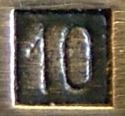




Napkin rings











|
A full WMF mark image for the second group contains some secondary markings. The fraction "I/O" means the normal thickness of silver or 1 gram of silver deposited onto the 1 dm2 surface of the base metal. The "O" letter put in a rounded cartouche or (later) in a rhombus means an increased thickness (1.5 g per 1 dm2) of deposited silver layer. I suppose that these two grades refer to the silver amounts of 60 g and 90 g per two dozen pieces of standard cutlery. Sometimes, for large items, the amount of deposited silver (in grams) is mentioned by the corresponding digit in the rectangle box. It should be emphasized that some early full WMF cutlery marks, used in this period, contain no silvering designation. The size of the rhombus with "O" letter is between 1.2 mm x 2.3 mm and 1.3 mm x 2.6 mm.
Now some comments on the marks of napkins rings.
While the inscription WMFN (silvering on Neusilber) is given in italics, the WMFB inscription uses no italics. The two-letter inscription "OX" ("oxydiert" in German, "oxidized" in English) means artificial darkening of the silver surface to a grey colour. The two-letter inscription "as" in a cartouche means artificial darkening of the silver surface to a nearly black colour, the so-called " antique silver finish". The so-called "antler" mark has been developed from the Wurtemberg Coat of Arms and used at around 1900 on nickel silver flatware. The meaning of such marking is not clear. It could be 20 year jubilee of WMF firm or simply the celebration of new century. There are two varieties of this mark, one antler image is strait, while the other is convex. Here we are dealing with the "convex" antler mark. The size of the antler cartouche varies between 1.2 mm x 2.7 mm and 1.4 mm x 3.1 mm. Finally, the image of six-petal rosette, specially developed for napkin rings, means "Special order" or "Special issue".
|
|
3
|
c.1898 - c.1903

|
A special mark for WMF Argentan (Neusilber, Alpacca)-based silver-plated cutlery. It consists of the one-word inscription "GEISLINGEN" of 5.6-8.6 mm length, made with "serif" or "sans serif" fonts and put in a rectangular frame, sometimes together with the digit stating the amount of silver (in grams) used for the silvering of two dozen pieces of standard forks (or spoons). Rare.
|
|
|














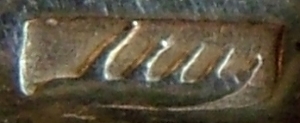
|
A full mark for this pattern includes the inscription in cartouche DRP 76975 (for marks GEISLINGEN 90, GEISLINGEN 60, and GEISLINGEN 40) and/or the antler mark. DRP refers to Deutsches Reich Patent (German State Patent). Here we are dealing with the "strait" antler image. The size of the rectangular frame with the antler mark varies between 0.9 mm x 2.8 mm and 1.2 x 2.6 mm.
|
|
4
|
c.1886 - c.1895

|
The oldest WMF export mark which was used simultaneously on hollow ware and cutlery items. It contains a "fancy" three-letter WMF inscription, put in an oval. The peculiarity of this mark is a broken "F" letter in the WMF inscription. The size of the oval is about 1.5 mm x 2.8 mm. Very rare.
|
|
|
c.1895 - c.1903


|
The next WMF export mark for cutlery items was used for items exported to the UK (or US) in the above-mentioned period. Such mark contains again a three-letter WMF inscription with dots (preferentially) or without. Contrary to the previous export cutlery mark, this one was made with a "serif" font and put in a rectangular frame. The length of the three-letter WMF inscription varies in the range 4.5-4.8 mm. Rare.
|
|
|












|
A full mark for WMF cutlery items, exported to the UK (or US), contains only few secondary marks. The fraction "I/O" means the normal thickness of silver deposited onto the surface of the base metal. The box "40" designates the silver amount of 40 g per two dozen pieces of standard cutlery, that refers to a lower quality silvering. The amount of deposited silver (in grams) for large items is given by the corresponding digit in the rectangle box (boxes "8", "4.5" and "2.5"). The size of the rectangular frame with the "strait" antler mark varies between 1.0 mm x 2.4 mm and 1.3 mm x 2.8 mm.
|
|
5
|
c.1903 - c.1910


|
The famous ostrich mark consists of the image of an ostrich set inside the "horizontal" rhombus. The size of horizontal rhombus varies between 1.4 mm x 2.1 mm and 1.9 mm x 3.1 mm, depending on the size of cutlery.
|
|
|






















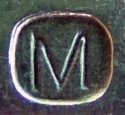


|
The basic full mark for this period consists of the rhombus with the ostrich image, the factory name WMF (made with a "serif" font) and different silvering designations: "O" (means 90 grams of silver per 24 forks/spoons), "I/O" (means 60 grams of silver per 24 forks/spoons), 40 (means 40 grams of silver per 24 forks/spoons), etc. or digits referring to the amount of silver in grams, deposited solely on one item: 6, 5, etc. Silvering designation is often given together with factory name in one rectangular frame or separately. The size of the rhombus with "O" letter measured on one item from my collection is 1.4 mm x 2.3 mm. The size of the I/O box, measured on five items from my collection, varies between 1.8 mm x 1.9 mm and 1.9 mm x 2.0 mm. The length of the WMF inscription varies in the range 3.0-3.8 mm and in the range 2.9-4.0 mm if the WMF inscription is given in italics (larger for longer pieces of cutlery). Italics are usually applied in the case of space shortage for marking. There are also two secondary markings, referring to the base metal: "M" (short for Messing, which means brass) and "ALPACCA" (sometimes given shortly as "ALP. ", which refers to nickel silver). It should be noted that often the use of brass (Messing) is not designated at all. The size of the "M" box is about 1.6 mm x 1.9 mm. The length of the "ALPACCA" inscription is 6.4 mm.
|
|
6
|
c.1903 - c.1910

|
This variety of ostrich mark, namely, the "ostrich in vertical rhombus", was used for exported products. The size of vertical rhombus varies between 1.7 mm x 3.4 mm and 2.0 mm x 3.6 mm, depending on the size of cutlery. Beautiful and very rare!
|
|
|




|
The full mark consists of the rhombus with the ostrich image, the factory name WMF (made with a "serif" font) in a cartouche and box with silvering designation "I/O" (means 60 grams of silver per 24 forks or spoons). The use of brass (Messing) as a base metal is not designated at all. The length of the WMF inscription is 3.6-3.8 mm. The box with the I/O designation is either nearly quadratic with the size about 1.8 mm x 1.9 mm or rectangular with the size 1.7 mm x 2.1 mm.
|
|
7
|
c.1909 - c.1920

|
The next ostrich mark was developed for export goods sent to France, it was valid simultaneously for the hollow ware and the cutlery pieces. In my opinion, after 1914 the export to France was stopped due to obvious reasons and after that this mark was mostly applied to the goods made from non-ferrous metals and their alloys, like copper, brass, nickel, etc. The silver-plated cutlery products with this mark are rather rare. This mark bears the image of a running ostrich inserted in the rhombus with a two-line inscription WMF/G, which in turn is placed inside a fully-dashed arch. The size of the arch measured on seven silver-plated pieces from my collection varies between 1.2 mm x 2.0 mm and 2.0 mm x 2.8 mm. Rather rare.
|
|
|




Napkin ring



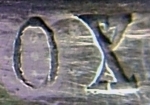
|
The full mark image includes a few secondary designations described above. The size of the box with I/O designation, measured on three items from my collection, is about 1.8 mm x 2.0 mm.
The full mark put on the napkin ring contains the ostrich mark with the arch of 1.3 mm x 2.0 mm size. The size of the "B" letter, which designates the use of Britannia metal as a base metal for silvering, is 1.1 mm x 2.0 mm. The other secondary marks used on the napkin rings are discussed above.
|
|
|
c.1909 - c.1930

|
If there is only a main mark presented without any silvering designation, then the object contains no silver. As it was mentioned above, such mark was mainly applied to the ladles made from non-ferrous metals and their alloys, like copper, brass, nickel, etc. It slightly differs from the previous ostrich mark for silver-plated items, as it contains a distorted rhomb image. As a result, the width of such "rhombus" is noticeably smaller than the height. The size of the arch, measured on five pieces from my collection, varies between 2.6 mm x 3.9 mm and 4.5 mm x 6.3 mm. Rather rare.
|
|
8
|
c.1910 - c.1925


|
This small-size ostrich mark was used in Germany for both silver-plated hollow ware and cutlery. It bears the image of a running ostrich put inside the rhombus with a two-line inscription WMF/G, which in turn was placed inside a partly-dashed arch. Sometimes, the form of the rhombus could be far from ideal. The size of the arch varies between 1.2 mm x 1.8 mm and 1.7 mm x 2.5 mm. A widespread mark.
|
|
|








Napkin rings






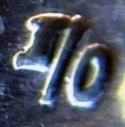



|
The full mark image for cutlery contains many secondary markings, some of them are new. Rarely, the use of brass as a base metal is designated by the one-letter inscription "M" (shortening from Messing). Usually, the use of brass as a base metal is not designated at all. The size of the "M" box varies between 1.4 mm x 1.5 mm and 1.6 mm x 1.9 mm, depending on the size of cutlery. The one-word inscription "ALPACCA" (nickel silver) refers to the use of nickel silver as a base metal. The length of the inscription "ALPACCA" is 6.8 mm. Sometimes, in the case of lack of space, this designation is given shortly as "ALP. "" The length of the word "ALP" (without a dot) is 3.1 mm. The form of the box with the silvering designation I/O could change from quadratic to rectangular, the size of the box varies between 1.4 mm x 1.4 mm and 1.9 mm x 2.0 mm. The size of the "O" rhombus varies between 1.2 mm x 2.3 mm and 1.4 mm x 2.1 mm.
The size of arch on napkin rings varies between 1.2 mm x 1.9 mm and 1.4 mm x 2.1 mm. The absence of any letter near the arch means the use of brass (Messing) as a base metal. The letter "N" designates the use of Neusilber (nickel silver) as a base metal. The letter "B" indicates the use of Britannia metal as a base metal for silvering. The size of both "N" and "B" letters varies between 0.7 mm x 1.0 mm and 0.8 mm x 1.1 mm. The two-letter inscription "OX" ("oxydiert" in German, "oxidized" in English) means artificial darkening of the silver surface to a grey colour. The one-letter inscription "g" means "vergoldet" in German or "gilt" in English. Finally, the image of six-petal rosette, specially developed for napkin rings, means "Special order" or "Special issue".
|
|
|

Napkin ring

|
If the full mark represents a combination of the main mark and the inscription "ALPACCA" (or the "N" letter in the case of napkin ring) without any silvering designation, then this piece is made from pure nickel silver. The length of the inscription "ALPACCA" varies between 6.7 mm and 7.3 mm. The size of the "N" letter is 0.8 mm x 1.1 mm. The size of the arch is 1.5 mm x 2.1 mm (1.5 mm x 2.0 mm in the case of napkin ring).
|
|
9
|
c.1920 - c.1925

|
A special mark, developed for cheap pieces of cutlery with a low level of silvering, about 20 g of silver per two dozen pieces of standard cutlery (forks or spoons). The size of the arch is 2.0 mm x 3.3 mm. The size of the box with digit "20" is 0.9 mm x 1.3 mm.
|
|
10
|
c.1920 - c.1930
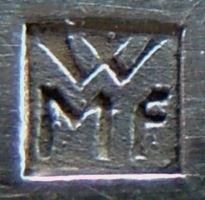
|
In around 1920, two new cutlery marks were introduced, the first one for standard table cutlery pieces (including knives), the second one for special large-size cutlery (ladles, cake servers, spoons for ragout, etc.). The mark for standard cutlery contains a 2D combination of three letters, "W", "M", and "F", put in a rectangle. The size of the rectangle is between 1.5 mm x 1.6 mm and 2.0 mm x 2.2 mm. Rather rare.
|
|
|



|
The full mark image contains silvering designations of two types. Either the whole silvering process is designated (the amount of silver used for silvering of 24 standard forks or spoons) or, additionally to that number, the amount of silver deposited on the surface of one dozen pieces of concrete cutlery is shown.
|
11
|

|
If there is a combination of previous mark and the inscription "CHROMARGAN" without any silvering designation, then the object is made of pure nickel-chrome steel (patented by WMF under the trade name of "CHROMARGAN"). Extremely rare.
|
|
12
|
c.1920 - c.1930



|
The second WMF cutlery mark for the same period 1920-1930, used for special large-size cutlery, consists of three-letter inscription "WMF", put inside the rectangle or, more rarely, inside a rectangular box (this could be an export mark!). The length of the WMF inscription varies in the range 3.1-4.7 mm. If there is a lack of space for marking, italics are used.
|
|
|





|
The full marks contain the silvering designation for the whole process (the amount of silver used for silvering of 24 standard forks or spoons) or digits referring to the amount of silver in grams, deposited solely on one item (rarely). Note, that if main mark is given in a rectangular (in a rectangle), the silvering designation is also made in a rectangular (in a rectangle). If main mark is given in italics, the silvering designation is also made in the same manner.
|
|
13
|
c.1925 - c.1930
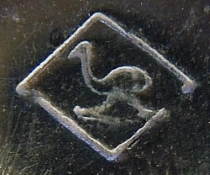
|
The Art Deco WMF cutlery mark for the items of higher artistic quality (usually for ladles). It contains the image of the running ostrich in a rhombus and similar to hollow ware mark, but contrary to hollow ware exists only in one version with the round tail of ostrich. The size of the rhombus is about 4.6 mm x 5.6 mm. No secondary markings were found for this mark.
|
Dr. David N. Nikogosyan
- 2016, 2017 -
|
|
















